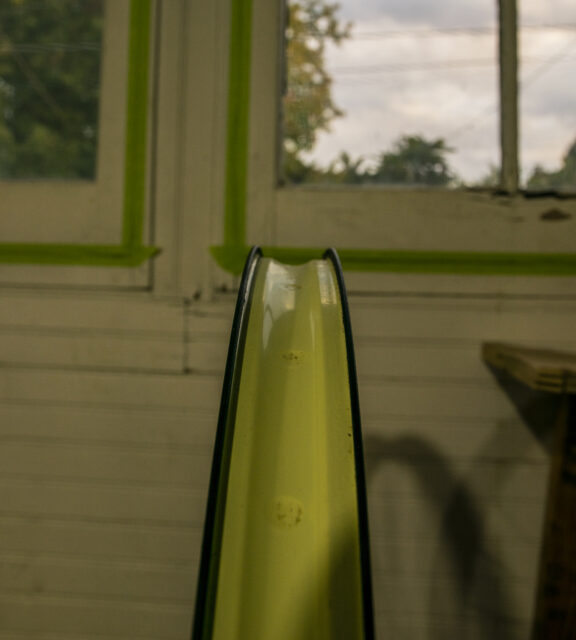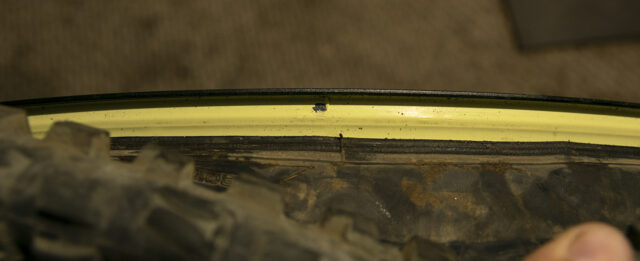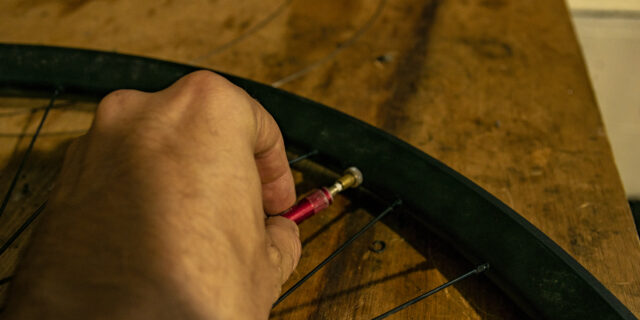Intro
Most mountain bikers run tubeless tires these days, but getting them set up can be a pain — and indeed, we called out tubeless tire systems as being one of the biggest potential areas for improvement on mountain bikes way back in Episode 14 of Bikes & Big Ideas. Here we’ve got a number of tricks for making your tubeless experience a bit less painful.
Tubeless Tire Tricks
Right off the bat, the vast majority of problems with tubeless setups have to do with the rim tape. Getting the tape dialed is critical to getting a tubeless tire to seal properly, and it’s easy to mess it up in a number of different ways, so here are some of our best tips for doing tape well.
(1) Before you start taping, get the rim as clean as you possibly can. If there’s old tape residue on there, do what you can to clean that off. At a minimum, wipe every bit of grime and old sealant off the rim, then clean it with a fresh rag and isopropyl alcohol, and let that dry before you proceed. More concentrated isopropyl is a better cleaner than the lower percentage stuff, largely because it evaporates much faster. The high-test 99% alcohol is great if you can find it; 91% is pretty good too. A lot of drug store isopropyl is 70% which takes way longer to dry, but does work in a pinch. Just give it way more time than you think you need to.
(2) Choose your tape wisely. For starters, getting the width right is critical. While the main point of the tape is to cover and seal the spoke holes, you’re far better off getting full coverage across the entire inside cavity of the rim. If your rim tape is narrower than full width, it’s much more likely that you’ll inadvertently catch the edge of it with the tire bead or a lever when installing / removing tires, and peel the tape up. Once that happens it’s game over — you’re redoing the tape. Aiming for tape roughly 2–4mm wider than the measured inner width of your rim is a good rule of thumb for most rims, but the ideal size may vary depending on the exact profile of the rim in question.

Gorilla Tape is a popular choice for tubeless tape, and is one of the most robust options out there. It’s not that expensive, readily available at most hardware stores, and easy to cut to the exact width you need. It’s not without its downsides, though — it’s prone to leaving adhesive residue on the rim, it’s heavy, and it’s thicker than most dedicated rim tapes, which can make it harder to mount tires, depending on the tire / rim combination being used. That said, it’s also stickier and more durable than most dedicated rim tapes, which can make it a lot less troublesome if you’re not bothered by the aforementioned downsides.
Among the dedicated rim tapes I’ve tried, the tape from DT Swiss is easily my favorite. It’s a bit stickier than average, doesn’t leave residue on the rim, and is available in a ton of different widths to suit whatever rims you might be using. It’s not as tough as Gorilla Tape, but it’s way lighter, thinner, and easier to clean up, should you need to remove it (which you will eventually).
(3) Apply the tape smoothly, and overlap it at the valve hole so that the valve stem anchors both ends. If you happen to have a truing stand, putting the wheel in it so the wheel is both held steadily and can spin freely definitely makes this easier, but it’s not necessary. Start just before the valve hole, and lay the tape in the center of the rim. Hold down the end with one hand, and work your way around the rim, unspooling tape and laying it down while pulling on the spool to keep the tape taught. As you go, work your way along the rim with the hand that started holding the tape down, pressing it into the rim cavity so that it sticks and adheres. Make sure the tape is sitting flat and smooth around the whole rim — if you’ve got bubbles, you’re going to have a bad time. Once you make it all the way around, overlap the tape by 4–6’’ so that both ends are anchored by the valve stem, and cut the end square with scissors.
(4) The hole in the tape for the valve stem is also a common source of leaks. When using rim-specific tapes, such as those from DT Swiss, Stan’s, Orange Seal, and others, the best way to make a clean hole that won’t propagate and tear is to melt one, rather than poking through with something sharp. I like to use a soldering iron, though you could probably get creative with heating up a nail or something along those lines. Just don’t burn yourself. Get your implement nice and hot, and go slowly and gently. If it doesn’t glide right through with minimal pressure, it’s not hot enough yet.

(5) Make sure the tape is really adhered solidly before you start putting sealant in. Installing the tire with a tube overnight to press the tape down is a great way to do this, but isn’t 100% necessary. If you’re in more of a rush, just carefully run your fingers around the rim while pressing down firmly to adhere the tape as completely as possible. Do this as you go while applying the tape, and work in the same direction that you’re laying it down.
(6) Be careful in installing the tire, especially if you resort to using levers. It’s easy to catch the rim tape with a tire lever and tear it or peel up an edge. Most combinations of tire and rim can be done without a lever with the right technique. Take care to work the tire bead into the lower center cavity of the rim as you go around, so there’s as much slack as possible. If you do need to use a lever, don’t lever up farther than is absolutely necessary, and make sure you don’t contact the rim tape with the tip of the lever.

(7) Normal Presta valves don’t flow very much air. If you’re having a hard time getting the tire to seat once you’ve mounted it, removing the valve core for more flow usually helps. A dedicated valve core tool (I have the Stan’s one) is cheap and makes the process easier, but pliers work too. Just take care not to bend the valve stem. Once you’ve got the tire seated, you’ll need to re-install the valve core and re-inflate the tire.
[There’s a huge development in tubeless valve tech dropping soon. We can’t say more yet, but… these new ones are seriously awesome. Stay tuned.]

(8) There are two main ways to add sealant — either before you install the second bead of the tire, or by removing the valve core and injecting it through the stem after the tire is seated. The former is a little easier; the latter lets you make sure the tire will seat nicely before you make a mess. Up to you.
(9) Finally, once you’ve got the tire seated and sealant added, make sure you get it coating the entire inside of the tire. My preferred technique is to set the wheel upright so that the sealant pools at the bottom, then pick the wheel up and swing it around to roll the sealant around that bottom portion of the tire. I then set the wheel back upright, with the wheel rotated slightly to get to the next section of the tire, and repeat until I’ve worked my way all around.
And that’s it! Hopefully by now you’ve got a nicely sealed, fully seated tire. And as always, let us know what you think in the comments, or if you have any tricks of your own that might help.



And don’t forget the tricks for seating a tubeless tire(inflating it after installing), if the air is just rushing out the sides:
– remove the valve core (already mentioned)
-Make sure the tire covers the valve (got this wrong again last night) on both sides ;-)
-Hold the wheel upright, push the tire down over the valve and into the ground.
-If that doesn’t work, wrap a strap around the entire circumference of the tire, to squeeze it down into the rim
And/or (5) just buy an air compressor. :)
I’m spoiled, I can’t go back.
I have had to do some, or all, of those, even while using an air compressor sometimes. Especially with fatbike tires.
A gas station compressor valve chuck for Schrader will fill a coreless Presta stem very quickly. just press it on like it’s a Schrader.